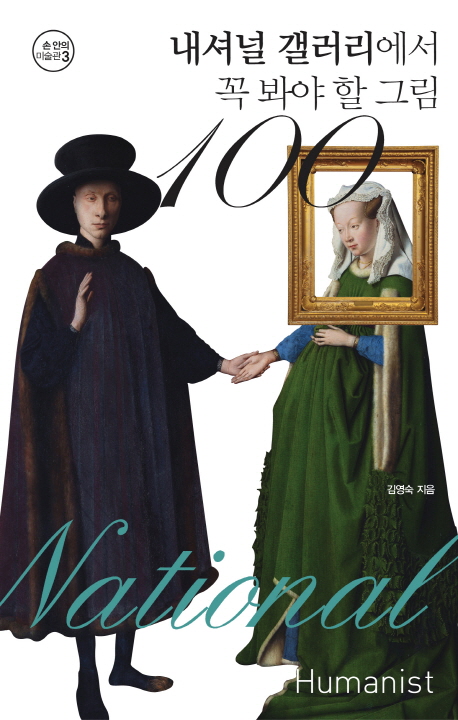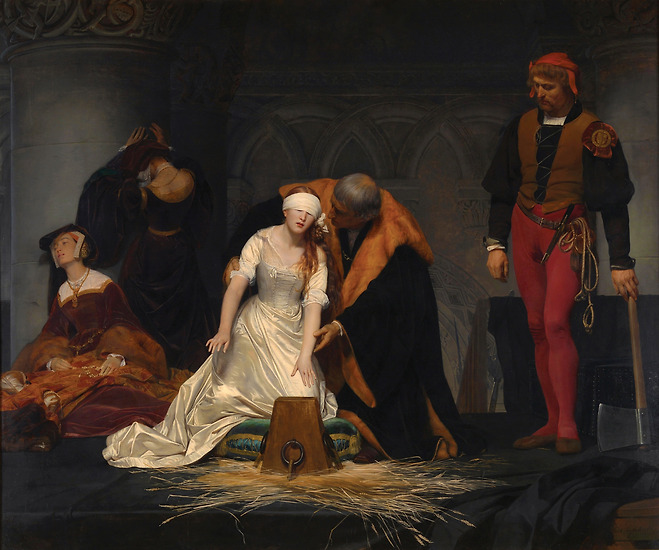폴 들라로슈
〈제인 그레이의 처형The Execution of Lady Jane Grey〉
순백의 드레스를 입은 가녀린 한 소녀가 눈을 가린 채 자신의 목이 놓일 형틀을 향해 손을 뻗고 있다. 그녀 바로 곁에 선 신부는 속삭이듯 그녀에게 목을 올려놓을 정확한 위치를 알려주는 모습이다. 오른쪽에 선 남자의 손에는 그녀의 목을 내리칠 도끼가 들려 있다.
그림 속 여인은 제인 그레이. 헨리 8세의 첫째 딸인 메리 1세의 명에 의해 형장의 이슬로 사라진 영국 역사상 첫 여왕이다. 헨리 8세는 스페인의 공주 캐서린과 결혼한 뒤 앤 불린과 사랑에 빠져 왕비를 폐위시킨다. 명목은 아들을 낳지 못했다는 것. 캐서린은 딸 메리 1세만을 낳았다. 헨리 8세는 앤과의 결혼을 위해 이를 불허하는 교황권에 등을 돌리고, 따로 영국 국교, 즉 성공회를 창설했다. 하지만 그의 사랑은 겨우 1,000일 남짓 이어질 뿐이었다. 이 ‘천일의 앤’은 바라던 아들 대신 딸 엘리자베스 1세만 낳은 뒤 왕의 또 다른 사랑을 위해 간통죄라는 주홍글씨를 새긴 채 단두대의 이슬로 사라져야 했다. 세 번째로 아내 제인 시모어는 그가 바라마지 않던 아들 에드워드 6세를 낳은 뒤 열흘 만에 세상을 떠났다. 헨리 8세는 이후에도 몇 번의 결혼을 감행하고 또 한 명의 왕비를 참수함으로써, 여섯 번 결혼에 아내 둘의 목을 베는 옹골찬 전력을 갖게 되었다.
그림의 주인공 제인 그레이는 헨리 8세 누이의 손주다. 외동아들 에드워드 6세가 헨리 8세의 뒤를 이었는데 열여섯 살에 세상을 떠나게 된다. 서열상 왕위 계승 1순위였던 에드워드 6세의 누나 메리 1세는 가톨릭 옹호자였다. 그러나 그녀가 왕위에 등극하면 헨리 8세가 창시한 성공회의 기반이 약해질 것을 우려한 이들이 아무 것도 모르는 제인 그레이를 왕위에 등극시켜버렸다. 불행히도 이 영국 최초의 여왕은 딱 아흐레만 왕으로 재임하고 이후 메리 1세와 가톨릭 옹호자들에 의해 폐위당했고, 이내 참수형을 당하고 만다.
폴 들라로슈(Paul Delaroche, 1797~1859)는 프랑스의 화가로, 1822년 살롱전을 통해 화단에 데뷔했다. 그로부터 10여 년 뒤에는 아카데미 부설 미술학교인 에콜드보자르의 교수로 취임했다. 그는 역사적 내용을 담되 낭만적인 서정성이 물씬 풍기는 그림으로 인기가 높았다.
도서

내셔널 갤러리 여행을 위한 명화 안내서! 런던의 트라팔가 광장에 자리한 영국 최고의 국립 미술관 내셔널 갤러리는 중세 말기와 르네상스를 거쳐 19세기 말까지 회화 20....펼쳐보기
집필자
Subject
Lady Jane Grey was the great-granddaughter of Henry VII of England and first cousin once removed to his grandson, the short-lived Edward VI. After the king's death she was proclaimed queen, being given precedence over Henry VIII's daughters, Mary Tudor and Elizabeth. Two weeks after the death of her brother, Mary, who had the support of the English people, claimed the throne, which Jane relinquished, having reigned for only nine days. Jane, her husband Lord Guilford Dudley, and her father, were imprisoned in the Tower of London on charges of high treason. Jane's trial was conducted in November, but the death penalty handed to her was temporarily suspended. In February 1554, Jane's father, who had been released, was one of the rebel leaders in Wyatt's rebellion. on Friday 12 February, Mary had Jane, then aged 16, and her husband beheaded. Her father followed two days later.[3]
Treatment
Delaroche painted the subject of Lady Jane's execution in 1833, nearly 300 years after the event, drawing upon contemporary historical sources to help him portray it accurately. Delaroche had built his reputation in the Paris salon with large, realistic portrayals of famous events from the previous few centuries.[4] Despite the artist's familiarity with the painting of historical narratives, there are aspects of the painting which are inaccurate.
The painting depicts the moment that Jane, blindfolded, is being assisted to lay her head upon the block for the executioner. Her outstretched hand reaches uncertainly down to find the block. She is being assisted by a man who is identified as John Brydges, 1st Baron Chandos. Chandos was a Lieutenant of the Tower at the time of Jane's execution.[5] While imprisoned in the Tower, Jane was attended by ladies in waiting, one of whom was the nursemaid of her infancy. Two ladies in waiting are depicted in the painting, showing their grief at the event which is about to take place.
The execution actually was conducted in the open air, in a part of the grounds of the Tower of London that is known as Tower Green, and where Henry VIII's wives Anne Boleyn and Catherine Howard had been executed. The painting indicates either that Delaroche was not familiar with this aspect of the event and has constructed the location according to his historical knowledge of other such events, or that he chose to take a great deal of artistic license.
In the picture, the execution is taking place upon a raised wooden platform similar to those on which executions of royalty and nobility had taken place in the French Revolution. The edge of this platform can be seen, draped with a black cloth, across the foreground of the picture. At the rear of the pictorial space the handrail of stairs descends, and the tops of two weapons indicate the presence of guards. Delaroche was presumably aware that the Tower of London was founded by William of Normandy. In the painting, two stout Norman columns with cushion capitals, a blind arcade, and a large chevroned arch create a backdrop indicative of the antiquity of the site. However, the buildings within the Tower of London span the reigns of many monarchs. In fact, the execution took place outside the Chapel of St Peter ad Vincula, which was constructed not at the time of William the Conqueror but by order of Henry VIII, and therefore in a style postdating that of the architecture in the painting by nearly 500 years.
It is difficult to ascertain by the setting and the lighting whether it was the artist's intention to create the impression that the scene was taking place outside a building or in an interior. The architectural features shown can occur on both interiors and exteriors of Norman buildings. The darkness of the upper part of the painting is suggestive of an interior, while the light that bathes the central figure is daylight. Ghislaine Kenyon, Head of Education at the National Gallery, commented on the sense of foreboding that the darkness was intended to create.[4]
The intensely dark areas that occupy a large proportion of the painting's surface play a big part in the drama. Not only is the shadow of the upper section of the painting black, so also are the cloth that covers the platform, the dress of one of the ladies, the cloak of Baron Chandos and the sleeves of the executioner. Three garments form accents of warm colour, the brown dress of one of the ladies, the orange fur of the Lieutenant's collar and the blood-red hose of the executioner. The colour of Lady Jane's red-gold hair is picked up in the straw beneath the block. Against the darkness, Lady Jane, with her pallid flesh, her white bodice and satin petticoat, makes a splash of light. The artist seizes the eye of the viewer by placing the most intense patches of white on Jane's blindfold and the area of her skirt just between her outstretched hand and the sharply defined edge of the block.
Delaroche has used many small details in telling the story and increasing the dramatic and emotive quality of the painting. The figures play their parts like actors through the expressions and gestures of grief and despair of the two women, the almost fatherly tenderness with which the Lieutenant of the Tower assists the blindfolded girl to take up the required position and the displeasure in the face of the executioner at the task that confronts him. Other narrative details include the rings on the block with the ropes which lash it steady to the floor, and the well-honed but well-worn edge to the axe. Kenyon points out that the clean straw, commonly placed near the site of an execution to soak up blood,[5] and the white dress were devices used by the artist to make the observer suppose what would happen to them next.[4]
Provenance
The painting was made after the July Revolution of 1830 which deposed Charles X of France, the last of the French Bourbon monarchs. Charles X's brother was Louis XVI of France whose throne was "usurped" and who was executed during the French Revolution. It is also redolent of the execution of Marie-Antoinette. Unsurprisingly, the emotive painting caused something of a sensation.[5] The painting was highly popular in the Paris salon when it was first exhibited there in 1834.[4]
It was originally bought by Anatole Demidov, 1st Prince of San Donato as part of the Demidov collection. From there it passed in 1870 to Henry Eaton, 1st Baron Cheylesmore after whose death in 1891 it realised £1,575 (lot 78) at his sale at Christie's the next year, less than a quarter of the price of the star of the sale, The Monarch of the Glen (lot 42, £7,245) by Sir Edwin Landseer, one of the most popular paintings of the age.[6] It was bought by his son, William Eaton, 2nd Baron Cheylesmore, who bequeathed it to the National Gallery, London in 1902, with four other paintings, including two other Landseers from his father's collection.[7]
The painting was thought to have been destroyed in the disastrous Tate Gallery flood of 1928 during the 1928 Thames flood, and was only rediscovered in 1973 by Tate Gallery curator Christopher Johnstone. He was writing a book on the British painter John Martin and going through the damaged canvases remaining from the flood in search of a missing painting by the artist. He found Martin's The Destruction of Pompeii and Herculaneum, albeit in very poor condition, rolled inside the Delaroche painting which was in perfect condition and transferred to the National Gallery where it should have gone when the national art collections were rationalised following the establishment of the Tate Gallery.
[참고 자료 -The Execution of Lady Jane Grey]
'♣ 미술(美術) 마당 ♣ > - 작품[作品]' 카테고리의 다른 글
| 빈센트 반 고흐 〈레 베스노 마을〉 (0) | 2016.08.28 |
|---|---|
| [공주형의 생각하는 미술관]<29>기억의 초상 (0) | 2016.07.26 |
| [동영상]명화 속 숨은이야기 - 영상 해설사 홍옥희 (0) | 2016.04.12 |
| 성녀 마리아 막달레나[Mary Magdalene]를 그린 그림들 (0) | 2016.02.10 |
| [시인이자 고급창부인 Tullia d'Aragona를 모델로 한 작품] -Reclining woman, by Heintz (0) | 2016.02.07 |


